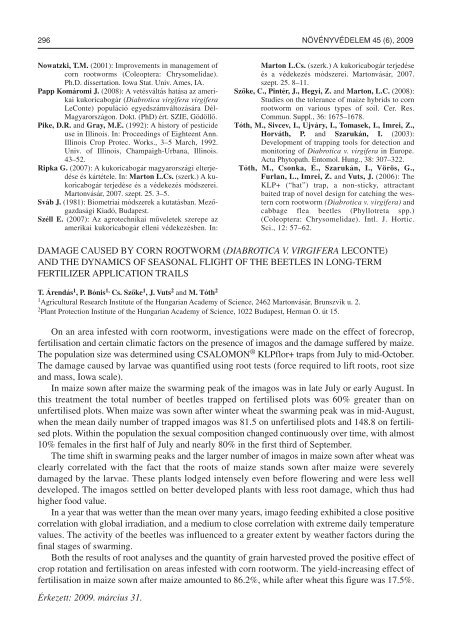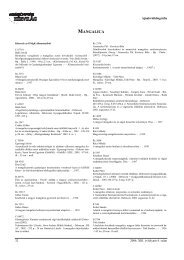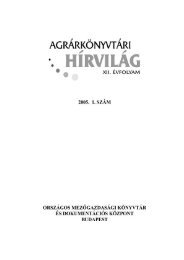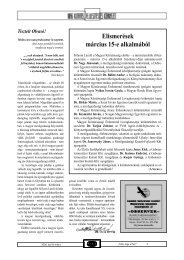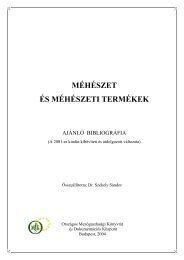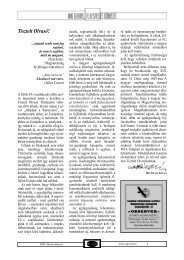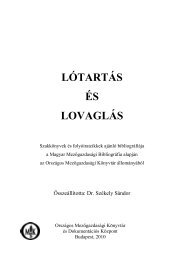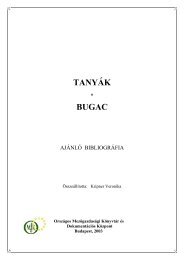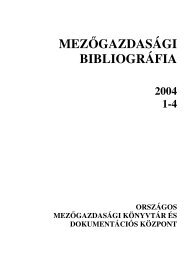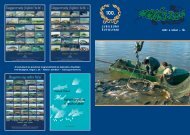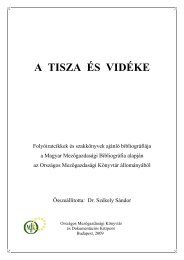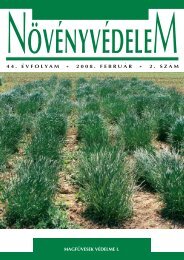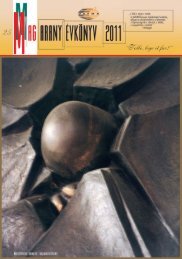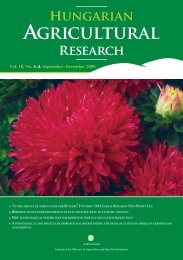45. ÃVFOLYAM * 2009. JÃNIUS * 6. SZÃM A KÃRIS VÃDELME
45. ÃVFOLYAM * 2009. JÃNIUS * 6. SZÃM A KÃRIS VÃDELME
45. ÃVFOLYAM * 2009. JÃNIUS * 6. SZÃM A KÃRIS VÃDELME
Create successful ePaper yourself
Turn your PDF publications into a flip-book with our unique Google optimized e-Paper software.
296 NÖVÉNYVÉDELEM 45 (6), 2009<br />
Nowatzki, T.M. (2001): Improvements in management of<br />
corn rootworms (Coleoptera: Chrysomelidae).<br />
Ph.D. dissertation. Iowa Stat. Univ. Ames, IA.<br />
Papp Komáromi J. (2008): A vetésváltás hatása az amerikai<br />
kukoricabogár (Diabrotica virgifera virgifera<br />
LeConte) populáció egyedszámváltozására Dél-<br />
Magyarországon. Dokt. (PhD) ért. SZIE, Gödöllô.<br />
Pike, D.R. and Gray, M.E. (1992): A history of pesticide<br />
use in Illinois. In: Proceedings of Eighteent Ann.<br />
Illinois Crop Protec. Works., 3–5 March, 1992.<br />
Univ. of Illinois, Champaigh-Urbana, Illinois.<br />
43–52.<br />
Ripka G. (2007): A kukoricabogár magyarországi elterjedése<br />
és kártétele. In: Marton L.Cs. (szerk.) A kukoricabogár<br />
terjedése és a védekezés módszerei.<br />
Martonvásár, 2007. szept. 25. 3–5.<br />
Sváb J. (1981): Biometriai módszerek a kutatásban. Mezôgazdasági<br />
Kiadó, Budapest.<br />
Széll E. (2007): Az agrotechnikai mûveletek szerepe az<br />
amerikai kukoricabogár elleni védekezésben. In:<br />
Marton L.Cs. (szerk.) A kukoricabogár terjedése<br />
és a védekezés módszerei. Martonvásár, 2007.<br />
szept. 25. 8–11.<br />
Szôke, C., Pintér, J., Hegyi, Z. and Marton, L.C. (2008):<br />
Studies on the tolerance of maize hybrids to corn<br />
rootworm on various types of soil. Cer. Res.<br />
Commun. Suppl., 36: 1675–1678.<br />
Tóth, M., Sivcev, I., Ujváry, I., Tomasek, I., Imrei, Z.,<br />
Horváth, P. and Szarukán, I. (2003):<br />
Development of trapping tools for detection and<br />
monitoring of Diabrotica v. virgifera in Europe.<br />
Acta Phytopath. Entomol. Hung., 38: 307–322.<br />
Tóth, M., Csonka, É., Szarukán, I., Vörös, G.,<br />
Furlan, L., Imrei, Z. and Vuts, J. (2006): The<br />
KLP+ (“hat”) trap, a non-sticky, attractant<br />
baited trap of novel design for catching the western<br />
corn rootworm (Diabrotica v. virgifera) and<br />
cabbage flea beetles (Phyllotreta spp.)<br />
(Coleoptera: Chrysomelidae). Intl. J. Hortic.<br />
Sci., 12: 57–62.<br />
DAMAGE CAUSED BY CORN ROOTWORM (DIABROTICA V. VIRGIFERA LECONTE)<br />
AND THE DYNAMICS OF SEASONAL FLIGHT OF THE BEETLES IN LONG-TERM<br />
FERTILIZER APPLICATION TRAILS<br />
T. Árendás 1 , P. Bónis 1, Cs. Szôke 1 , J. Vuts 2 and M. Tóth 2<br />
1 Agricultural Research Institute of the Hungarian Academy of Science, 2462 Martonvásár, Brunszvik u. 2.<br />
2 Plant Protection Institute of the Hungarian Academy of Science, 1022 Budapest, Herman O. út 15.<br />
On an area infested with corn rootworm, investigations were made on the effect of forecrop,<br />
fertilisation and certain climatic factors on the presence of imagos and the damage suffered by maize.<br />
The population size was determined using CSALOMON ® KLPflor+ traps from July to mid-October.<br />
The damage caused by larvae was quantified using root tests (force required to lift roots, root size<br />
and mass, Iowa scale).<br />
In maize sown after maize the swarming peak of the imagos was in late July or early August. In<br />
this treatment the total number of beetles trapped on fertilised plots was 60% greater than on<br />
unfertilised plots. When maize was sown after winter wheat the swarming peak was in mid-August,<br />
when the mean daily number of trapped imagos was 81.5 on unfertilised plots and 148.8 on fertilised<br />
plots. Within the population the sexual composition changed continuously over time, with almost<br />
10% females in the first half of July and nearly 80% in the first third of September.<br />
The time shift in swarming peaks and the larger number of imagos in maize sown after wheat was<br />
clearly correlated with the fact that the roots of maize stands sown after maize were severely<br />
damaged by the larvae. These plants lodged intensely even before flowering and were less well<br />
developed. The imagos settled on better developed plants with less root damage, which thus had<br />
higher food value.<br />
In a year that was wetter than the mean over many years, imago feeding exhibited a close positive<br />
correlation with global irradiation, and a medium to close correlation with extreme daily temperature<br />
values. The activity of the beetles was influenced to a greater extent by weather factors during the<br />
final stages of swarming.<br />
Both the results of root analyses and the quantity of grain harvested proved the positive effect of<br />
crop rotation and fertilisation on areas infested with corn rootworm. The yield-increasing effect of<br />
fertilisation in maize sown after maize amounted to 8<strong>6.</strong>2%, while after wheat this figure was 17.5%.<br />
Érkezett: <strong>2009.</strong> március 31.


